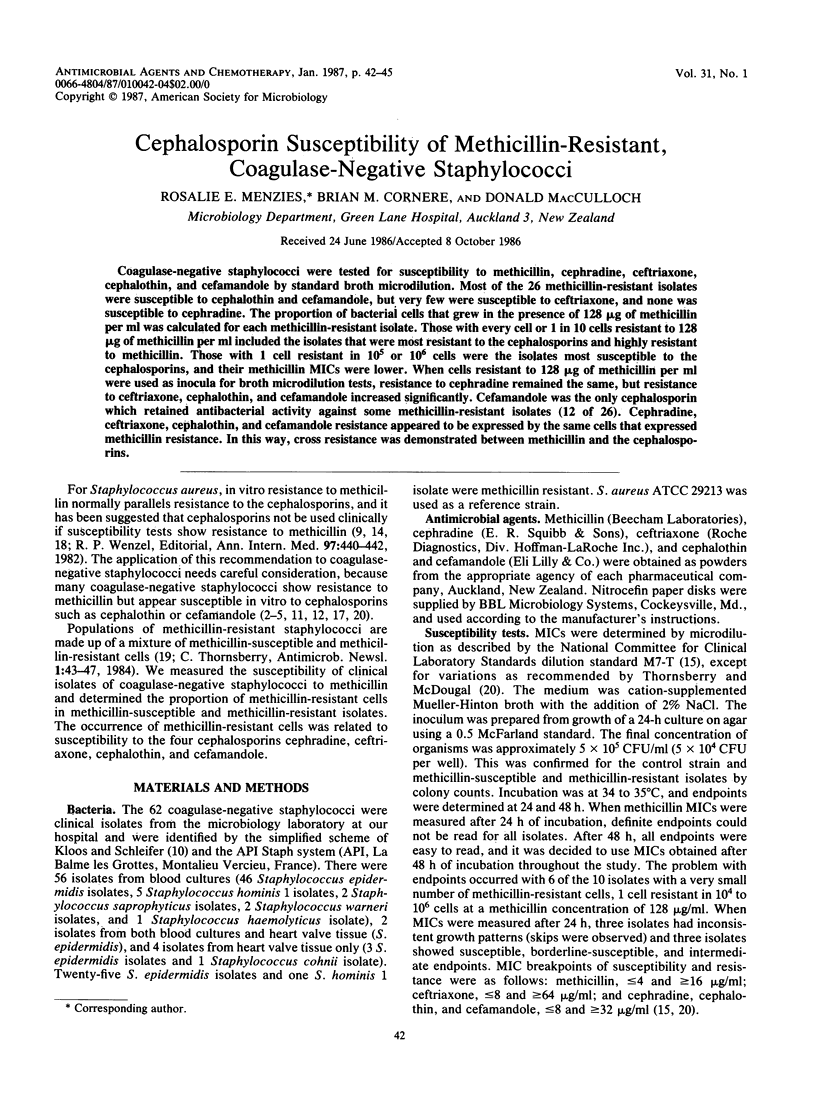Abstract
Coagulase-negative staphylococci were tested for susceptibility to methicillin, cephradine, ceftriaxone, cephalothin, and cefamandole by standard broth microdilution. Most of the 26 methicillin-resistant isolates were susceptible to cephalothin and cefamandole, but very few were susceptible to ceftriaxone, and none was susceptible to cephradine. The proportion of bacterial cells that grew in the presence of 128 micrograms of methicillin per ml was calculated for each methicillin-resistant isolate. Those with every cell or 1 in 10 cells resistant to 128 micrograms of methicillin per ml included the isolates that were most resistant to the cephalosporins and highly resistant to methicillin. Those with 1 cell resistant in 10(5) or 10(6) cells were the isolates most susceptible to the cephalosporins, and their methicillin MICs were lower. When cells resistant to 128 micrograms of methicillin per ml were used as inocula for broth microdilution tests, resistance to cephradine remained the same, but resistance to ceftriaxone, cephalothin, and cefamandole increased significantly. Cefamandole was the only cephalosporin which retained antibacterial activity against some methicillin-resistant isolates (12 of 26). Cephradine, ceftriaxone, cephalothin, and cefamandole resistance appeared to be expressed by the same cells that expressed methicillin resistance. In this way, cross resistance was demonstrated between methicillin and the cephalosporins.
Full text
PDF



Selected References
These references are in PubMed. This may not be the complete list of references from this article.
- Archer G. L. Antimicrobial susceptibility and selection of resistance among Staphylococcus epidermidis isolates recovered from patients with infections of indwelling foreign devices. Antimicrob Agents Chemother. 1978 Sep;14(3):353–359. doi: 10.1128/aac.14.3.353. [DOI] [PMC free article] [PubMed] [Google Scholar]
- Davies A. J., Clewett J., Jones A., Marshall R. Sensitivity patterns of coagulase-negative staphylococci from neonates. J Antimicrob Chemother. 1986 Feb;17(2):155–160. doi: 10.1093/jac/17.2.155. [DOI] [PubMed] [Google Scholar]
- Davies A. J. Coagulase negative staphylococcal infections. Br Med J (Clin Res Ed) 1985 Apr 27;290(6477):1230–1231. doi: 10.1136/bmj.290.6477.1230. [DOI] [PMC free article] [PubMed] [Google Scholar]
- Frongillo R. F., Bianchi P., Moretti A., Pasticci M. B., Ripa S., Pauluzzi S. Cross-resistance between methicillin and cephalosporins for staphylococci: a general assumption not true for cefamandole. Antimicrob Agents Chemother. 1984 May;25(5):666–668. doi: 10.1128/aac.25.5.666. [DOI] [PMC free article] [PubMed] [Google Scholar]
- Gruer L. D., Bartlett R., Ayliffe G. A. Species identification and antibiotic sensitivity of coagulase-negative staphylococci from CAPD peritonitis. J Antimicrob Chemother. 1984 Jun;13(6):577–583. doi: 10.1093/jac/13.6.577. [DOI] [PubMed] [Google Scholar]
- Hartman B. J., Tomasz A. Expression of methicillin resistance in heterogeneous strains of Staphylococcus aureus. Antimicrob Agents Chemother. 1986 Jan;29(1):85–92. doi: 10.1128/aac.29.1.85. [DOI] [PMC free article] [PubMed] [Google Scholar]
- Hartman B. J., Tomasz A. Low-affinity penicillin-binding protein associated with beta-lactam resistance in Staphylococcus aureus. J Bacteriol. 1984 May;158(2):513–516. doi: 10.1128/jb.158.2.513-516.1984. [DOI] [PMC free article] [PubMed] [Google Scholar]
- John J. F., Jr, McNeill W. F. Activity of cephalosporins against methicillin-susceptible and methicillin-resistant, coagulase-negative staphylococci: minimal effect of beta-lactamase. Antimicrob Agents Chemother. 1980 Feb;17(2):179–183. doi: 10.1128/aac.17.2.179. [DOI] [PMC free article] [PubMed] [Google Scholar]
- Klimek J. J., Marsik F. J., Bartlett R. C., Weir B., Shea P., Quintiliani R. Clinical, epidemiologic and bacteriologic observations of an outbreak of methicillin-resistant Staphylococcus aureus at a large community hospital. Am J Med. 1976 Sep;61(3):340–345. doi: 10.1016/0002-9343(76)90370-3. [DOI] [PubMed] [Google Scholar]
- Kloos W. E., Schleifer K. H. Simplified scheme for routine identification of human Staphylococcus species. J Clin Microbiol. 1975 Jan;1(1):82–88. doi: 10.1128/jcm.1.1.82-88.1975. [DOI] [PMC free article] [PubMed] [Google Scholar]
- Laverdiere M., Peterson P., Verhoef J., Williams D. N., Sabath L. D. In vitro activity of cephalosporins against methicillin-resistant, coagulase-negative staphylococci. J Infect Dis. 1978 Mar;137(3):245–250. doi: 10.1093/infdis/137.3.245. [DOI] [PubMed] [Google Scholar]
- Laverdiere M., Welter D., Sabath L. D. Use of a heavy inoculum in the in vitro evaluation of the anti-staphylococcal activity of 19 cephalosporins. Antimicrob Agents Chemother. 1978 Apr;13(4):669–675. doi: 10.1128/aac.13.4.669. [DOI] [PMC free article] [PubMed] [Google Scholar]
- McDougal L. K., Thornsberry C. The role of beta-lactamase in staphylococcal resistance to penicillinase-resistant penicillins and cephalosporins. J Clin Microbiol. 1986 May;23(5):832–839. doi: 10.1128/jcm.23.5.832-839.1986. [DOI] [PMC free article] [PubMed] [Google Scholar]
- Rossi L., Tonin E., Cheng Y. R., Fontana R. Regulation of penicillin-binding protein activity: description of a methicillin-inducible penicillin-binding protein in Staphylococcus aureus. Antimicrob Agents Chemother. 1985 May;27(5):828–831. doi: 10.1128/aac.27.5.828. [DOI] [PMC free article] [PubMed] [Google Scholar]
- SUTHERLAND R., ROLINSON G. N. CHARACTERISTICS OF METHICILLIN-RESISTANT STAPHYLOCOCCI. J Bacteriol. 1964 Apr;87:887–899. doi: 10.1128/jb.87.4.887-899.1964. [DOI] [PMC free article] [PubMed] [Google Scholar]
- Sheagren J. N. Staphylococcus aureus. The persistent pathogen (second of two parts). N Engl J Med. 1984 May 31;310(22):1437–1442. doi: 10.1056/NEJM198405313102206. [DOI] [PubMed] [Google Scholar]
- Thornsberry C., McDougal L. K. Successful use of broth microdilution in susceptibility tests for methicillin-resistant (heteroresistant) staphylococci. J Clin Microbiol. 1983 Nov;18(5):1084–1091. doi: 10.1128/jcm.18.5.1084-1091.1983. [DOI] [PMC free article] [PubMed] [Google Scholar]
- Ubukata K., Yamashita N., Konno M. Occurrence of a beta-lactam-inducible penicillin-binding protein in methicillin-resistant staphylococci. Antimicrob Agents Chemother. 1985 May;27(5):851–857. doi: 10.1128/aac.27.5.851. [DOI] [PMC free article] [PubMed] [Google Scholar]


